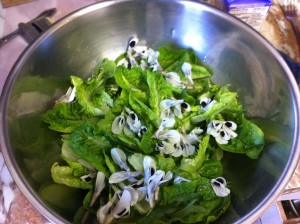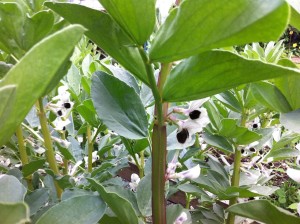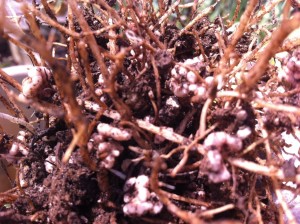The star of the last few weeks, both on the rooftop and in my home garden, is the fava bean, resplendent now in its floral display. In fact it’s the flowers, more than the beans to come, that interest me. Here they are blooming profusely on sturdy stems – handsome flowers on handsome plants.
And here’s why they interest me and the chefs at the Noble Rot – they are both tasty and visually attractive. Like the scarlet runner bean flower, fava flowers have a refreshing crunch under tooth and taste sweetly beany. Their black and white color combination is both unusual in the edible flower world and, in my opinion, adds elegance to any dish. My dinner salad this evening, while clearly not photo-shopped by a food stylist, still looks eye-catching thanks to the fava flowers. Otherwise it would have been tasty but visually unremarkable.
 |
| The harsh lighting and the blasé stainless salad bowl clearly do nothing for this photo, so thank God the fava flowers still can hold their own against the lack of a competent food stylist. |
At the Rot today I ripped out the fava plants, their flowers having been picked clean, yet with nary a bean to show for their lives. We’re not holding out for the beans because they wouldn’t yield a substantial enough harvest to merit the longer wait. Plus, if you’ve ever dealt with favas, you may agree there’s something psychologically deflating about harvesting the beans and cooking with them. When ready the huge bean pods rise suggestively off the plant at sharp angles, and just a few really seem to fill a harvest basket or bowl. Once in the kitchen, however, the pods are shelled to reveal lots of interior padding and very little bean, though the seeds there are of impressive size. But, as if to add insult to injury, the bean seeds need a second shelling, having a rather substantial seed coat surrounding them that must be removed before eating. Piled side by side, the compostable parts outnumber the edible parts at least ten to one. I’m letting some of the beans develop in my home garden, partly out of sheer laziness and partly out of pity, but at the restaurant we have no room for maudlin sentiments like that. It’s grab-the-flowers-and-thank-you-very- much-goodbye!
Still I don’t consider it a loss to have grown the crop and received only flowers for a yield. These beans, planted last fall, have been hard at work all winter below ground. As I ripped out these plants I let out a low whistle, being impressed by the sizeable nodules I found on the roots of every plant.
While people don’t normally get all excited about the word nodule, if you are an organic farmer you do. Nodules are root condominiums wherein live Rhizobia – soil-dwelling bacteria that can fix nitrogen from the air. Should you find yourself thinking, “Gee, I didn’t know the nitrogen was broken,” please recall that “fix” in this context means to convert molecular nitrogen, abundant in the atmosphere but unusable by plants, to nitrate nitrogen, which plants easily uptake. So in addition to providing us with beautiful, tasty flowers, these fava landlords and their underground bacterial lessees have been busy providing our garden with the most important (and most expensive) nutrient needed for growth. That free nitrogen is a boon for the garden is about as black and white as….a fava flower!


